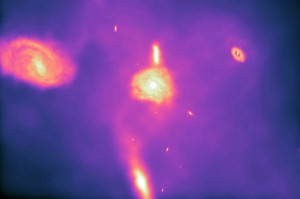
We have now reaching a point where there is enough computing power available to build a model of an entire universe filled with galaxies like those we observe around us.
“We’ve created the full variety of galaxies we see in the local universe,” said CfA’s Mark Vogelsberger, a postdoctoral fellow in the Harvard College Observatory.
In our reality we observe majestic spiral galaxies such as the Andromeda, the Pinwheel, and theWhirlpool. Spirals like those are common, but previous attempts to model a universe failed and ended up churning out blobby galaxies clumped into balls, clearly something was wrong. The problem was finally cracked by Volker Springel, group leader at HITS. His new software, called Arepo, starts with the observed afterglow of the big bang and successfully evolved forward in time for 14 billion years into what we observe in reality today.
“We took all the advantages of previous codes and removed the disadvantages,” explained Springel.
“Our simulations improve over previous ones as much as the Giant Magellan Telescope will improve upon any telescope that exists now,” said Debora Sijacki of the CfA and a fellow at the Harvard College Observatory. [As an aside, when completed later this decade, the Giant Magellan Telescope’s 24.5-meter aperture will make it the largest telescope in the world.]
So how exactly did Arepo solve the problem? The problem was that earlier models divided space into a bunch of cubes of fixed size and shape, Arepo takes a different approach and has a grid that flexes and moves in space to match the motions of the underlying gas, stars, dark matter, and dark energy.
Its not just the model, it is also the tin.
Harvard’s Odyssey high-performance supercomputer, a cluster of thousands of linux nodes, has enough computing crunch to run the model, and so 14 billion years was simulated in only a few months — if you tried running it on your desktop it would have taken rather a lot longer
What happens next?
Future goals include simulating much larger volumes of the universe at unprecedented resolution, thus creating the largest and most realistic model of the universe ever made.
Below is a computer animation created using the new software and simulates billions of years of cosmic history.